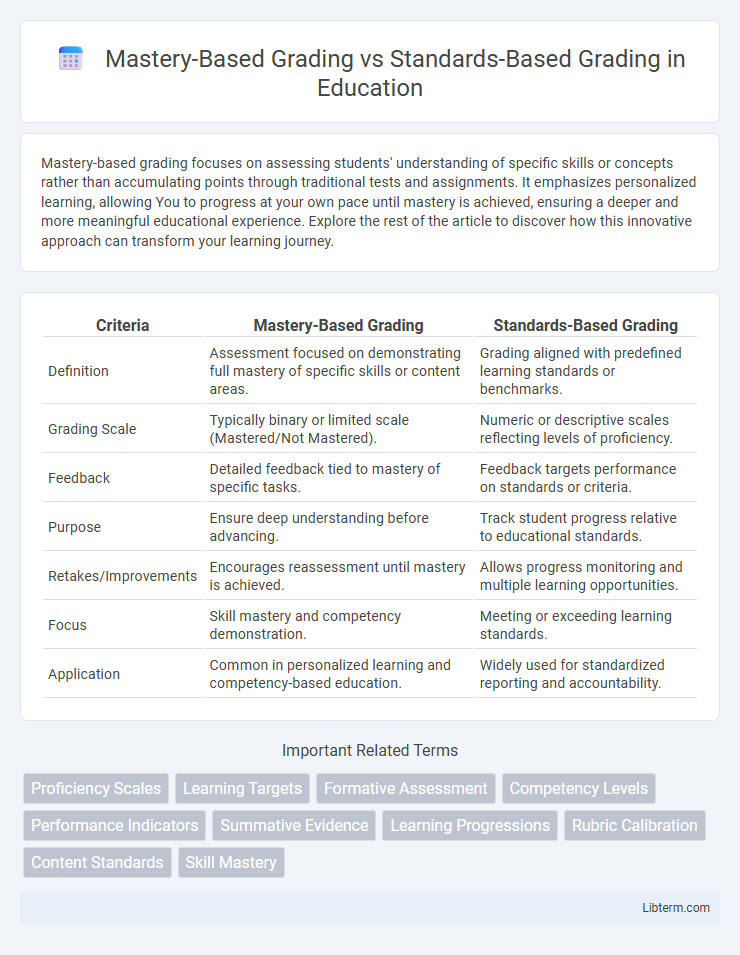Mastery-based grading focuses on assessing students' understanding of specific skills or concepts rather than accumulating points through traditional tests and assignments. It emphasizes personalized learning, allowing You to progress at your own pace until mastery is achieved, ensuring a deeper and more meaningful educational experience. Explore the rest of the article to discover how this innovative approach can transform your learning journey.
Table of Comparison
| Criteria | Mastery-Based Grading | Standards-Based Grading |
|---|---|---|
| Definition | Assessment focused on demonstrating full mastery of specific skills or content areas. | Grading aligned with predefined learning standards or benchmarks. |
| Grading Scale | Typically binary or limited scale (Mastered/Not Mastered). | Numeric or descriptive scales reflecting levels of proficiency. |
| Feedback | Detailed feedback tied to mastery of specific tasks. | Feedback targets performance on standards or criteria. |
| Purpose | Ensure deep understanding before advancing. | Track student progress relative to educational standards. |
| Retakes/Improvements | Encourages reassessment until mastery is achieved. | Allows progress monitoring and multiple learning opportunities. |
| Focus | Skill mastery and competency demonstration. | Meeting or exceeding learning standards. |
| Application | Common in personalized learning and competency-based education. | Widely used for standardized reporting and accountability. |
Understanding Mastery-Based Grading
Mastery-Based Grading emphasizes student proficiency by assessing whether learners have achieved specific skills or concepts at a high level of understanding, rather than averaging scores over time. This system allows multiple opportunities to demonstrate mastery, promoting continuous learning and reducing the pressure of traditional grading timelines. By focusing on competency rather than point accumulation, Mastery-Based Grading provides clearer insights into student progress and areas needing improvement.
What Is Standards-Based Grading?
Standards-Based Grading (SBG) measures student progress by evaluating performance on clearly defined learning standards rather than overall averages or percentages. Each standard represents specific skills or knowledge students must demonstrate mastery of, allowing teachers to provide detailed feedback and tailor instruction to individual needs. This approach promotes transparency, highlighting strengths and areas for improvement aligned with curriculum goals.
Core Principles: Mastery vs Standards
Mastery-Based Grading emphasizes students demonstrating deep understanding and proficiency in specific skills or concepts before progressing, ensuring personalized learning pacing. Standards-Based Grading evaluates performance against predefined criteria, assigning grades based on how well students meet established learning standards. Both systems prioritize clear learning goals but differ in focus: mastery centers on individual competency development, while standards emphasize uniform achievement benchmarks.
Assessment Practices Compared
Mastery-Based Grading emphasizes continuous assessment through formative quizzes, projects, and personalized feedback to ensure students demonstrate deep understanding of specific skills before advancing. Standards-Based Grading primarily evaluates students against clearly defined learning standards using summative assessments, focusing on proficiency levels rather than cumulative points. Both practices prioritize clear learning targets, but Mastery-Based Grading allows for retakes and improvements, while Standards-Based Grading often requires meeting fixed benchmarks within grading periods.
Feedback and Student Growth
Mastery-Based Grading emphasizes detailed, ongoing feedback that pinpoints specific skills students have mastered, fostering continuous improvement and personalized learning paths. Standards-Based Grading aligns feedback directly with predefined learning objectives, allowing teachers to clearly communicate student progress relative to grade-level expectations. Both approaches prioritize formative feedback to support student growth, but Mastery-Based Grading typically provides more granular insights into individual competencies.
Impact on Motivation and Engagement
Mastery-Based Grading emphasizes continuous improvement by allowing students multiple opportunities to demonstrate understanding, which often increases intrinsic motivation and persistence in learning. Standards-Based Grading clearly defines learning goals and assesses students on specific skills or knowledge, fostering self-awareness and targeted effort that can enhance engagement. Both approaches shift the focus from earning points to mastering content, promoting deeper learning and sustained student investment.
Grading Transparency and Communication
Mastery-Based Grading emphasizes clear criteria tied to specific skills, enabling students to understand their progress through detailed feedback on demonstrated competencies. Standards-Based Grading communicates achievement by aligning grades directly with learning standards, providing transparent evidence of student performance relative to predetermined benchmarks. Both methods enhance grading transparency and improve communication by focusing on objective, skill-based assessments rather than traditional point accumulation.
Challenges and Limitations
Mastery-Based Grading often faces challenges such as increased teacher workload due to individualized assessments and difficulties in consistently measuring student progress across diverse skills. Standards-Based Grading can encounter limitations with rigid adherence to predefined criteria that may overlook holistic learning and creativity. Both systems require significant professional development and shift in school culture to effectively address issues of subjectivity and ensure equitable evaluation.
Implementation Strategies
Mastery-Based Grading implementation involves continuous formative assessments and personalized feedback to ensure students achieve proficiency before progressing, emphasizing mastery of specific skills over time. Standards-Based Grading focuses on aligning evaluations directly with clear, predefined learning standards, using rubrics and frequent performance tracking to measure student progress against set benchmarks. Effective strategies for both include professional development for educators, consistent communication with students and parents, and leveraging technology for real-time data analysis to guide instruction.
Choosing the Right Approach for Your School
Choosing the right grading approach for your school involves evaluating the goals of student assessment and learning outcomes. Mastery-Based Grading emphasizes demonstrating comprehensive understanding through repeated assessments until mastery is achieved, while Standards-Based Grading aligns evaluations directly with defined learning standards and benchmarks. Consider factors such as curriculum alignment, teacher training, and stakeholder buy-in to select the system that best supports personalized learning and accurate reporting of student progress.
Mastery-Based Grading Infographic

 libterm.com
libterm.com